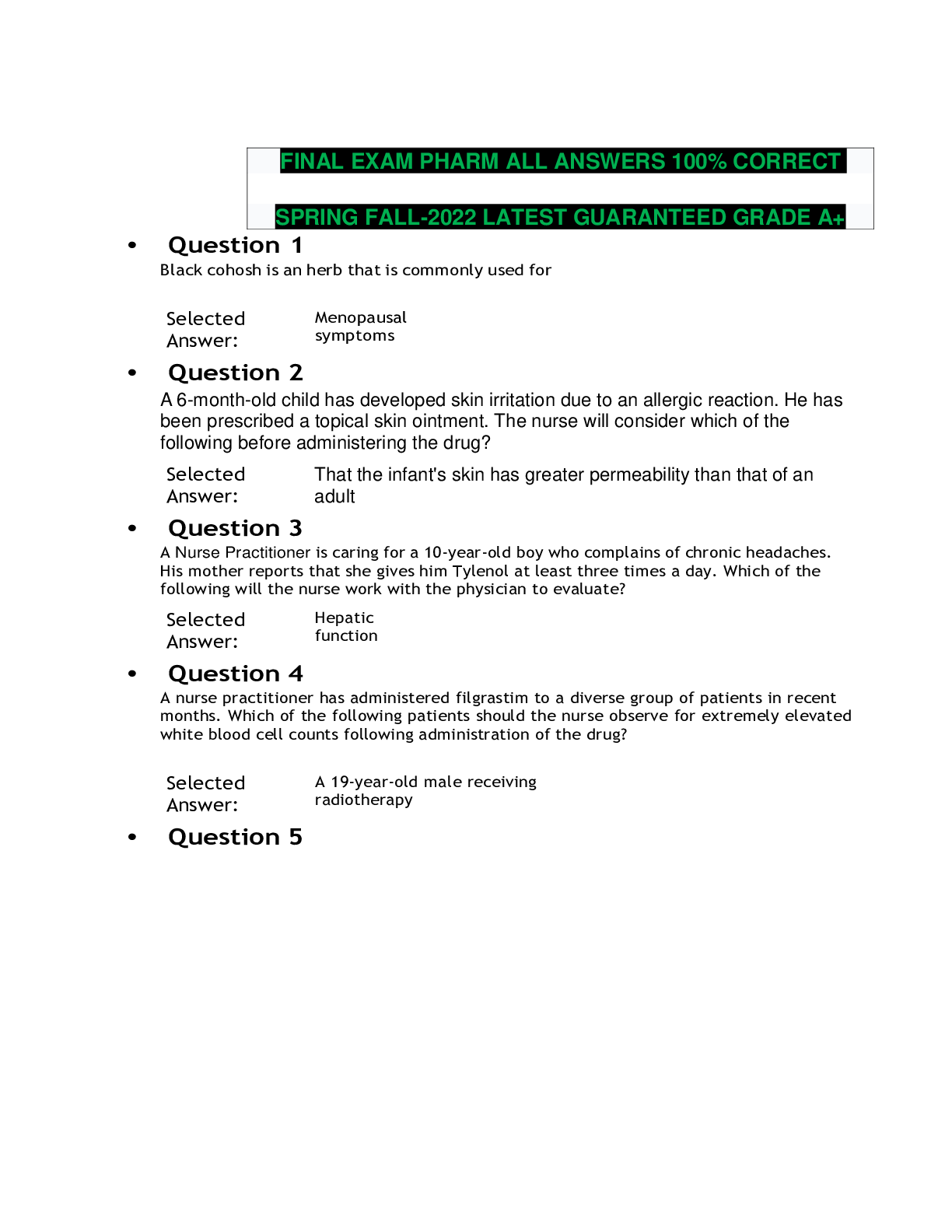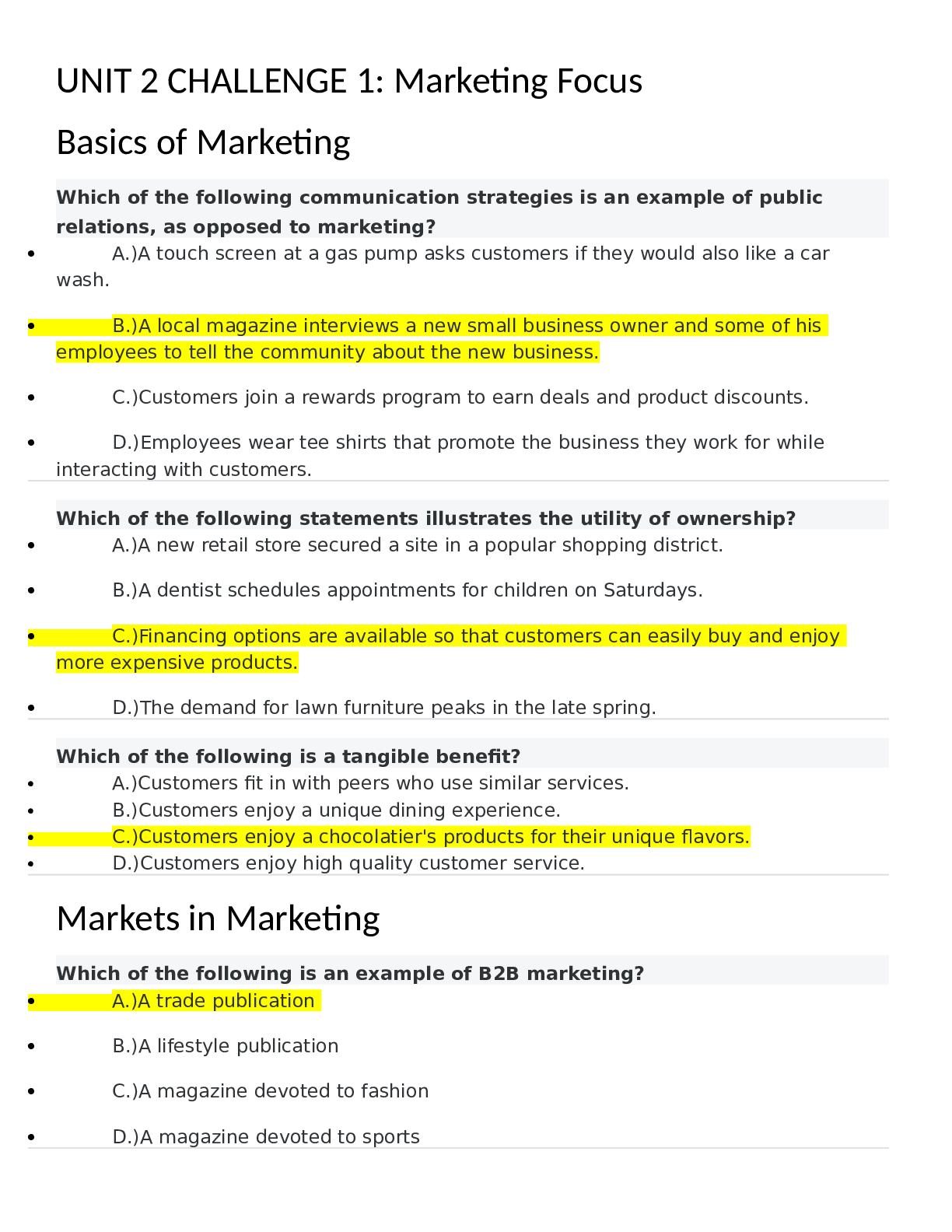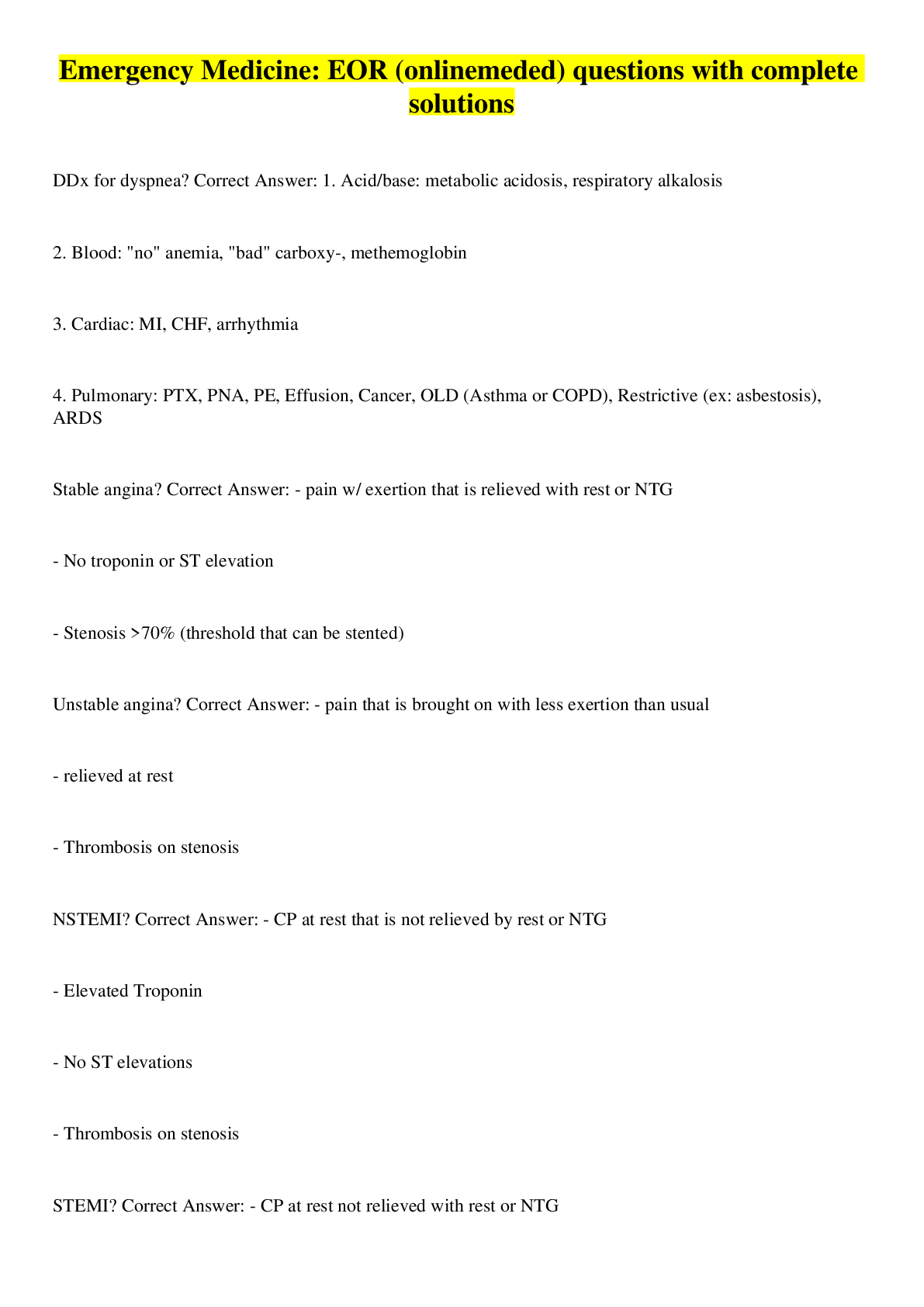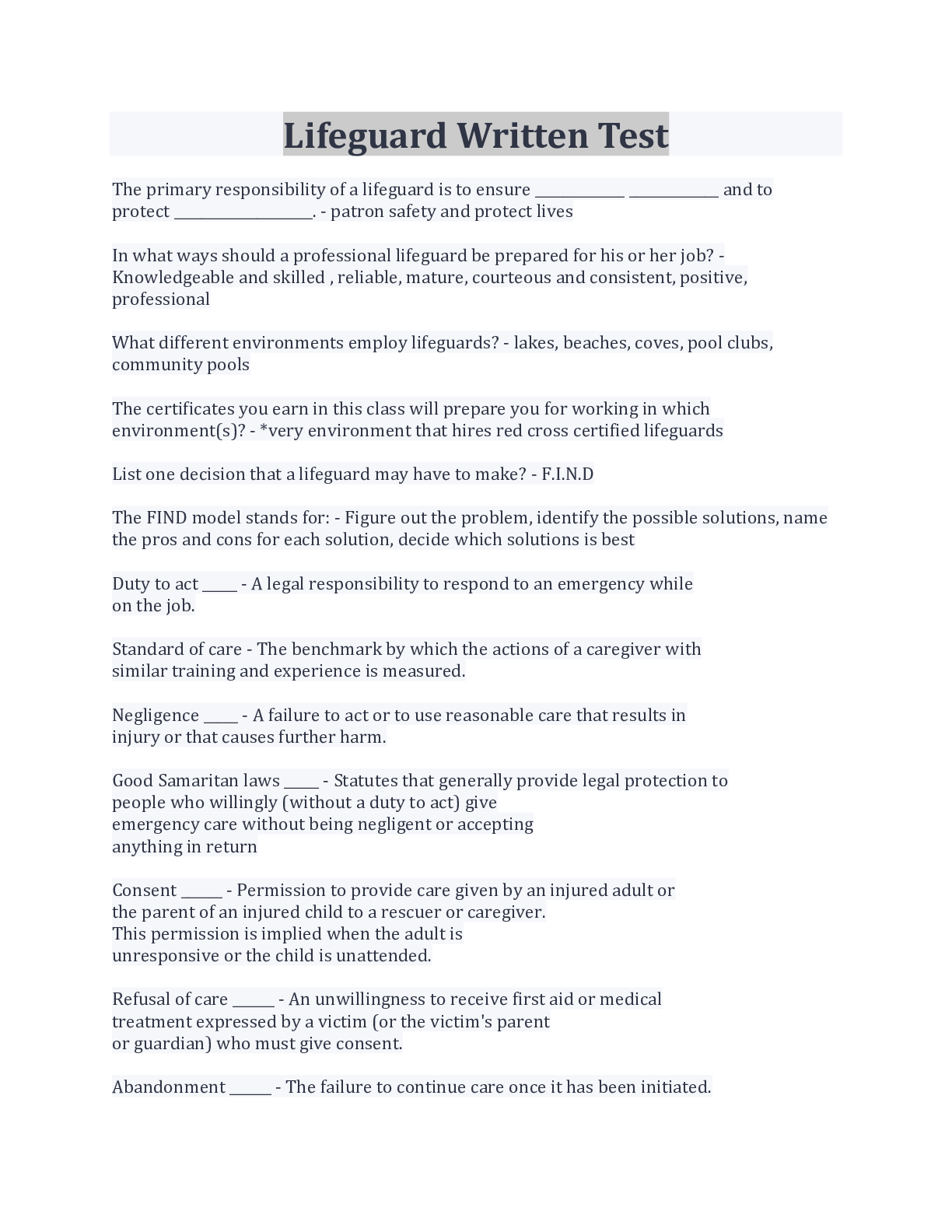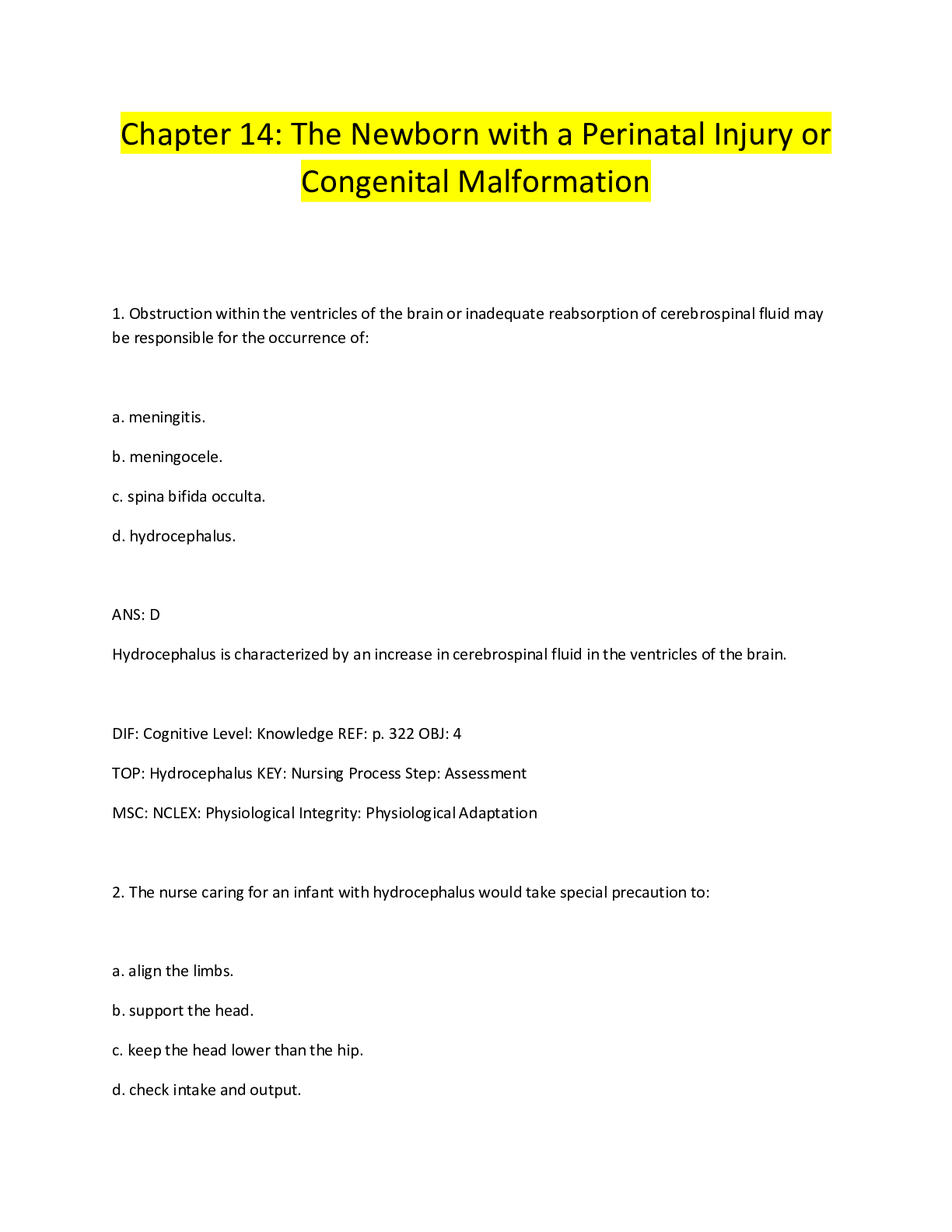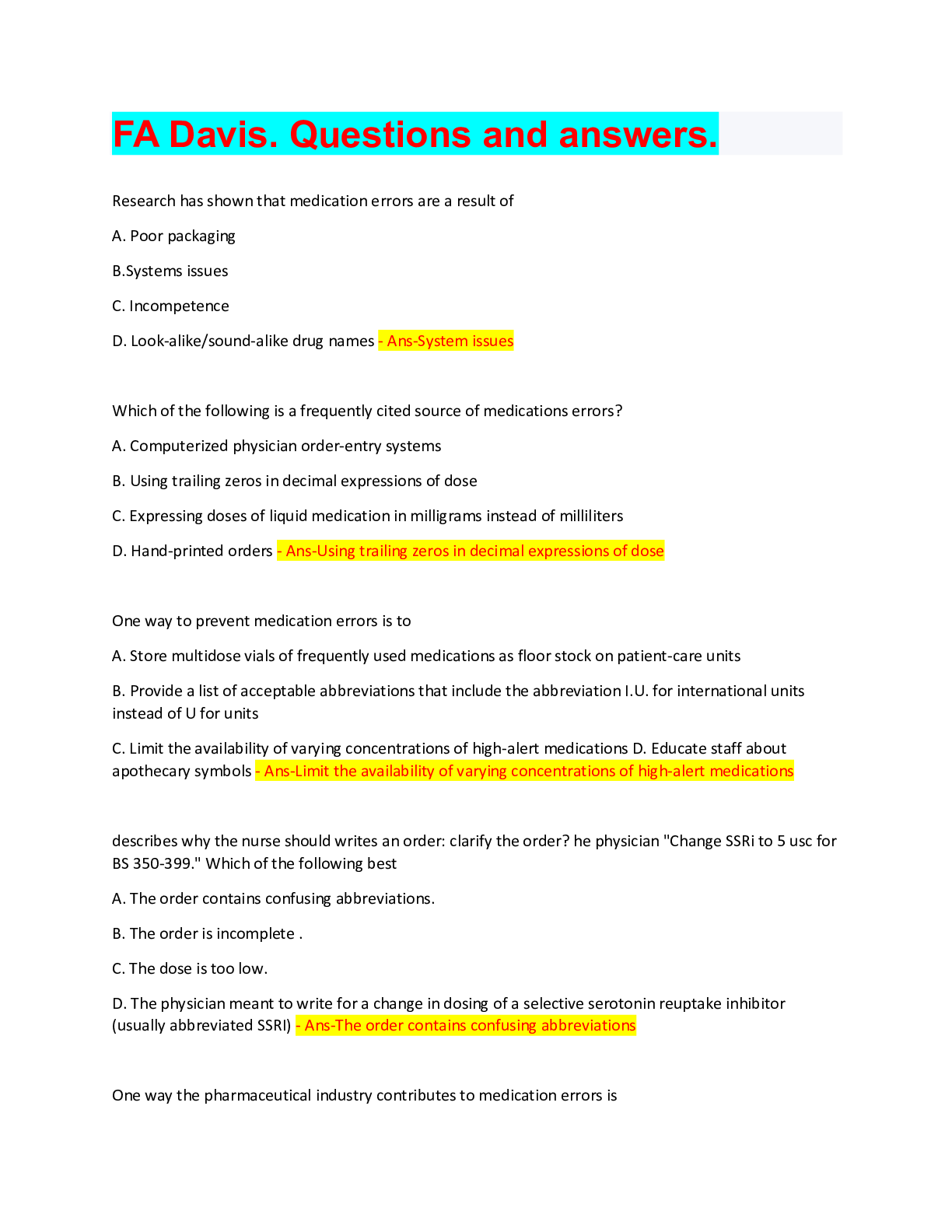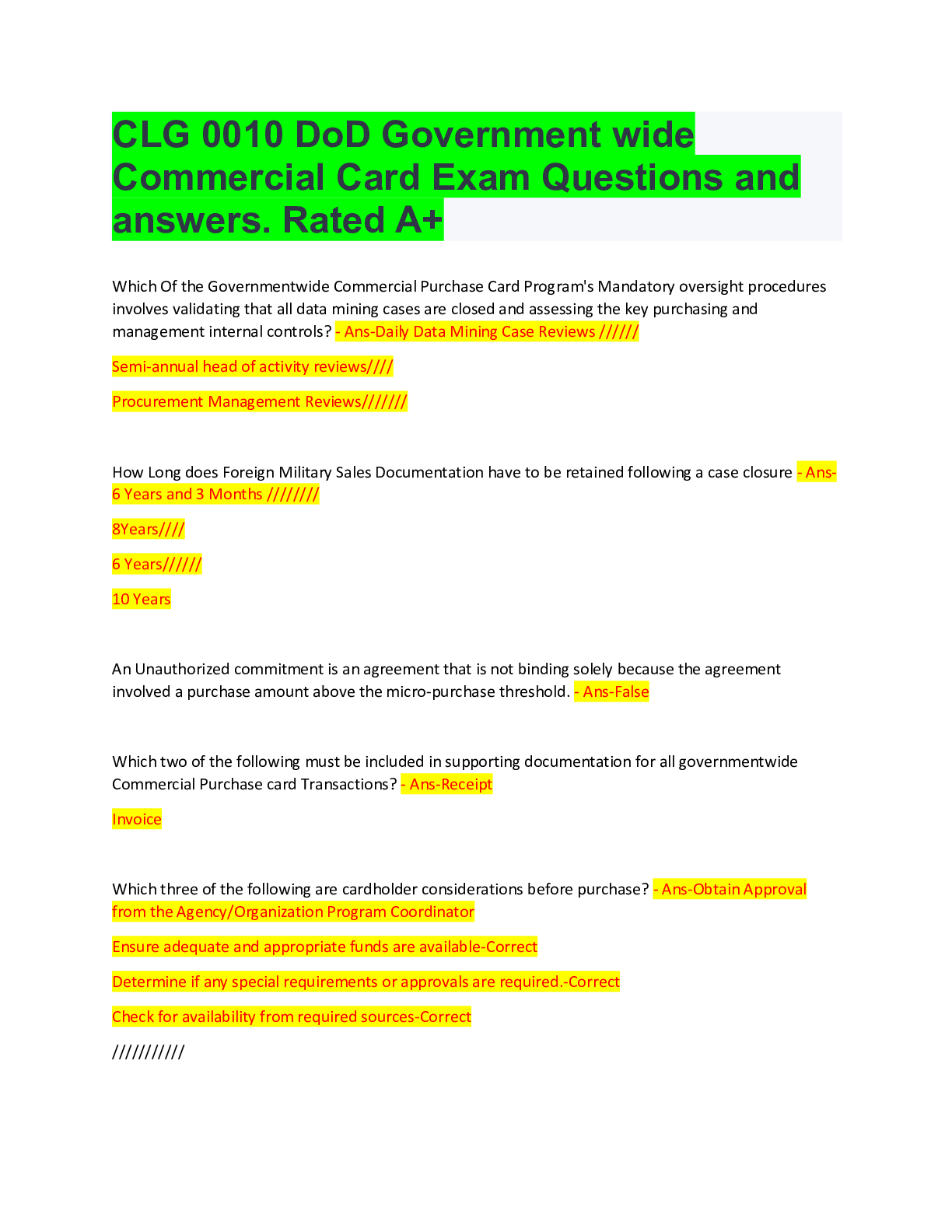*NURSING > QUESTIONS & ANSWERS > AEMT Full Chapters 1-20 Questions and Answers. Rated A. 2022/2023 update (All)
AEMT Full Chapters 1-20 Questions and Answers. Rated A. 2022/2023 update
Document Content and Description Below
AEMT Full Chapters 1-20 Questions and Answers A circular system of ongoing internal and external reviews is known as: - >>>>continuous quality improvement A self-motivated AEMT should be able to: -... >>>>discover problems and solve them without someone else's direction. Authorization to use an automatic transport ventilator when transporting a patient requires which level of EMS provider at a minimum? ->>>>EMT The recognition by one state of another state's EMS licensure is called: - >>>>reciprocity. Which of the following is an example of a secondary prevention strategy? - >>>>Educating the public regarding the use of helmets and seat belts Which of the following is NOT a standard licensure requirement for the AEMT? - >>>>Completion of an NREMT-developed AEMT course Which of the following scenarios does NOT involve an ALS skill? ->>>>Using an AED and performing rescue breathing You arrive at the scene of a domestic dispute. You can hear yelling and the sound of breaking glass from inside the residence. You should: ->>>>retreat to a safe place until the scene has been secured. A circular system of ongoing internal and external reviews is known as: - >>>>continuous quality improvement. A physician authorizes you, via two-way radio, to help a patient administer prescribed nitroglycerin. What type of medical direction is this? ->>>>Online medical control A self-motivated AEMT should be able to: ->>>>discover problems and solve them without someone else's direction. AEMT training follows National EMS Standards, as recommended by the: - >>>>National Highway Traffic Safety Administration After successfully completely a state-approved AEMT course, you are: ->>>>eligible to take your state's AEMT certification examination. All of the following are roles and responsibilities of the AEMT, EXCEPT: ->>>>providing definitive care for the patient's conditionAn AEMT administers the wrong medication to a patient. This is an example of: - >>>>knowledge-based error. An AEMT is trained and generally authorized to perform all of the following interventions EXCEPT: ->>>>interpretation of cardiac rhythms. An appropriate demonstration of professionalism when your patient is frightened, demanding, or unpleasant is to: ->>>>continue to be nonjudgmental, compassionate, and respectful. An EMS system's primary service area (PSA) is the area where: ->>>>the system is responsible for the provision of emergency care. As an AEMT, you may have to function as an advocate for your patient. This involves: - >>>>protecting the best interests of the patient. Authorization to use an automatic transport ventilator when transporting a patient requires which minimum level of EMS provider? ->>>>EMT Being aware and thoughtful about the needs of your patient describes the attribute of: - >>>>empathy Continuous quality improvement (CQI) involves all of the following components, EXCEPT: ->>>>negative feedback to those who make mistakes while on a call. Even with an EMS certification, your ability to function as an AEMT is governed locally by the: ->>>>EMS system's medical director. In an enhanced 9-1-1 system: ->>>>the phone number from which the call is made is displayed on a screen. In most states, a person may be denied certification as an AEMT if he or she: ->>>>has been convicted of a felony. Roles and responsibilities of the AEMT include: ->>>>identifying patients who are critically ill or injured. The function of the National Registry of EMTs is to: ->>>>assess competence through a valid testing process. The recognition by one state of another state's EMS licensure is called ->>>>reciprocity. To become a licensed AEMT, a candidate must: ->>>>successfully complete a healthcare provider CPR course.When managing any patient, the AEMT should: ->>>>maintain a nonjudgmental and compassionate attitude. Which of the following is an example of a secondary prevention strategy? - >>>>Educating the public regarding the use of helmets and seat belts Which of the following is NOT a standard licensure requirement for the AEMT? - >>>>Completion of an NREMT-developed AEMT course. Which of the following scenarios does NOT involve an ALS skill? ->>>>Using an AED and performing rescue breathing Which of the following scenarios involves an ALS skill? ->>>>Administering oxygen and infusing IV fluids. Which of the following statements regarding EMS research is correct? ->>>>AEMTs will be involved in research typically through gathering data While attempting resuscitation of a patient in cardiac arrest, you initiate CPR, defibrillate the patient with an AED, and insert a multilumen airway prior to contacting medical control. What does this scenario most accurately describe? ->>>>Standing orders Who regulates the standards under which the AEMT provides emergency care? - >>>>The State EMS office or agency You arrive at the scene of a domestic dispute. You can hear yelling and the sound of breaking glass from inside the residence. You should: ->>>>retreat to a safe place until the scene has been secured. A semiconscious 40-year-old female is found to have regular respirations at a rate of 24 breaths/min with reduced tidal volume. You should: ->>>>assist her ventilations with a bag-mask device. Cellular function deteriorates and death occurs when the pH: ->>>>drops below 6.9 or rises above 7.8. Chemoreceptors send messages to the brain to increase respirations when: - >>>>arterial carbon dioxide levels increase. For continuous positive airway pressure (CPAP) to be beneficial, the patient must: - >>>>be able to follow commands. If a multilumen airway device is inserted into the trachea: ->>>>it functions the same as an endotracheal tube.In contrast to the Combitube, the King LT airway: ->>>>has two cuffs that are simultaneously inflated. Patients receive the MOST benefit from continuous positive airway pressure (CPAP): - >>>>during the exhalation phase The Cobra perilaryngeal airway (CobraPLA) is contraindicated in patients: ->>>>with massive trauma to the oral cavity. The portion of the tidal volume that does not participate in pulmonary gas exchange is called: ->>>>dead space air. The preferred device to use when administering supplemental oxygen in the prehospital setting is the: ->>>>nonrebreathing mask Unresponsive patients MOST often experience airway obstructions from: - >>>>occlusion of the posterior pharynx by the tongue. When opening the airway of a non-injured unconscious apneic patient, you should perform a head tilt-chin lift maneuver and then: ->>>>insert an oropharyngeal airway. When suctioning the airway of a child, you should: ->>>>suction for 10 seconds and reassess the child's airway. When using the bag-mask device to ventilate an apneic patient who has dentures, you should: ->>>>periodically reassess the airway to ensure the dentures are not loose. When ventilating a patient with a stoma and a tracheostomy tube, you should: - >>>>attach the bag-mask device to the 15-mm adaptor on the tube. Which of the following patients should be placed in the recovery position? ->>>>A 33- year-old unconscious male without injury who has respirations of 22 breaths/min and good chest rise Which size oxygen cylinder is typically carried by the AEMT to the patient's side? - >>>>D Cylinder Which structure is located in the posterior aspect of the nasal cavity? - >>>>Nasopharynx While assessing a semiconscious 22-year-old female's respirations, you note that they are 16 breaths/min. You should: ->>>>assess the regularity and depth of the patient's breathing.You are ventilating a trauma patient with a bag-mask device, but are having difficulty maintaining an effective mask seal. Prior to inserting the King LT airway, you should: - >>>>protect the patient's spine as you position the head. A 19-year-old male has sustained severe facial trauma after being assaulted. He is responsive to pain only, has rapid and shallow respirations, and oropharyngeal bleeding. After opening the airway with the jaw-thrust maneuver, you should - >>>>suction his airway and assist ventilations with a bag-mask device. A 40-year-old male is unconscious, has inadequate breathing, and is producing copious, continuous secretions from his mouth. This situation is MOST effectively managed by: ->>>>suctioning for 15 seconds and ventilating for 2 minutes. A 43-year-old female is unconscious following an overdose of heroin. Her respirations are slow and shallow. Which of the following conditions will she initially develop if not treated? ->>>>Respiratory acidosis A 66-year-old female is in cardiac arrest and requires advanced airway management. Prior to inserting a Combitube, you should take standard precautions and then: - >>>>preoxygenate the patient with a bag-mask device and 100% oxygen. A 70-year-old male with a history of esophageal cancer is unresponsive with slow, shallow respirations. Appropriate airway management for this patient includes: - >>>>inserting an oral airway and ventilating with a bag-mask device. A 72-year-old male with a tracheal stoma requires ventilatory assistance. However, when you attempt to ventilate, you meet resistance. You should: ->>>>suction the stoma and mouth. A major advantage of the multilumen airway device is that it: ->>>>cannot be improperly inserted A male patient with a history of congestive heart failure presents with orthopnea. This means that: ->>>>the severity of his respiratory difficulty varies with position. A patient is found unconscious and trauma has been ruled out. The MOST appropriate method for opening the patient's airway is the: ->>>>head-tilt chin-lift maneuver. A portable oxygen cylinder should be taken out of service and refilled when the pressure inside it is at ________ psi or below: ->>>>500 A semiconscious 40-year-old female is found to have regular respirations at a rate of 24 breaths/min with reduced tidal volume. You should: ->>>>assist her ventilations with a bag-mask device.A stoma, located superior to the suprasternal notch, is the resultant orifice following a: - >>>>tracheostomy A supraglottic airway device: ->>>>does not enter the trachea or esophagus After inserting a King LT airway, you attach the bag-mask device and begin to ventilate the patient. However, you meet resistance with your initial ventilation attempts. You should: ->>>>withdraw the device slightly until ventilations are easy. After inserting the CobraPLA into your patient, you note that her tongue is protruding from her mouth. You should: ->>>>recognize that the device is not inserted far enough. After inserting the Combitube, the pharyngeal cuff is inflated with _____ mL of air and the distal cuff is inflated with _____ mL of air. ->>>>100, 15 All of the following conditions would cause a decreased concentration of oxygen in the blood, EXCEPT: ->>>>an increased respiratory rate All of the following would result in metabolic acidosis, EXCEPT: ->>>>an overdose of antacids. An 18-year-old female is experiencing an anxiety attack and is breathing at a rate of 40 breaths/min. Which of the following acid-base derangements will occur if her condition is not promptly treated? ->>>>↓ CO2 → ↓ H2CO3 → ↑ pH An apneic 2-year-old child with a heart rate of 110 beats/min is being ventilated with a bag-mask device at a rate of 20 breaths/min. After 2 minutes of ventilations, you note that the child's heart rate is 80 beats/min. You should: ->>>>recognize that your ventilations are not adequate. An oxygen humidifier is MOST beneficial when a patient is: ->>>>being given oxygen during a lengthy transport to the hospital. Carbonic acid is an ideal buffer because it: ->>>>is a weak acid and can accept or donate hydrogen ions. Cellular function deteriorates and death occurs when the pH: ->>>>drops below 6.9 or rises above 7.8 Chemoreceptors send messages to the brain to increase respirations when: - >>>>arterial carbon dioxide levels increase. Continuous positive airway pressure (CPAP) is indicated for patients with: - >>>>pulmonary edema CPAP produces all of the following physiologic effects, EXCEPT: ->>>>**During an attempted resuscitation from cardiac arrest, the patient inadvertently receives too much sodium bicarbonate. This would result in: ->>>>metabolic alkalosis. Following severe head trauma, a patient presents with an irregular rate, pattern, and depth of breathing with brief periods of apnea. This breathing pattern is characteristic of: ->>>>Biot's respirations. Hypoxia is a condition in which: ->>>>there is a lack of oxygen to the body's cells and tissues. If a multilumen airway device is inserted into the trachea: ->>>>it functions the same as an endotracheal tube. If the amount of pulmonary surfactant is decreased: ->>>>alveolar surface tension will increase. If the brain is deprived of oxygen for 4 to 6 minutes: ->>>>anoxic brain injury will occur. In contrast to the Combitube, the King LT airway: ->>>>has two cuffs that are simultaneously inflated. In contrast to the dorsal respiratory group, the ventral respiratory group is: - >>>>primarily responsible for motor control of the inspiratory and expiratory muscles. In order for continuous positive airway pressure (CPAP) to be beneficial, the patient must: ->>>>be able to follow commands. Internal respiration is defined as the: ->>>>exchange of oxygen and carbon dioxide at the cellular level. Internally, the lower airway extends from the: ->>>>glottis to the pulmonary capillary membrane. Intrapulmonary shunting occurs when: ->>>>nonfunctional alveoli inhibit the diffusion of oxygen and carbon dioxide. Minute volume would increase if: ->>>>respiratory rate was increased. Partial pressure is the term used to describe the amount of gas that is: ->>>>dissolved in fluid. Patients receive the MOST benefit from continuous positive airway pressure (CPAP): - >>>>during the exhalation phase. Prior to inserting an LMA, you must ensure that the: ->>>>cuff is fully deflated of air.Slow, shallow, irregular respirations or occasional gasps are MOST indicative of: - >>>>cerebral anoxia. The amount of air that is moved into or out of the lungs during a single breath is called: - >>>>tidal volume. The anterior portion of the cricoid ring is separated from the thyroid cartilage by the - >>>>cricothyroid membrane The Cobra perilaryngeal airway (CobraPLA) is contraindicated in patients: ->>>>** The condition in which the alveoli collapse is called: ->>>>atelectasis. The exchange of oxygen and carbon dioxide occurs by a process of diffusion, in which: ->>>>gas moves from an area of higher concentration to an area of lower concentration. The hypoxic drive stimulates breathing when the: ->>>>arterial oxygen level falls. The laryngeal mask airway (LMA) is indicated when: ->>>>intubation is not possible and mask ventilation is the only option. The lower portion of the pharynx that opens into the larynx anteriorly and the esophagus posteriorly is the: ->>>>hypopharynx. The lungs are covered with a thin, slippery outer membrane called the: ->>>>visceral pleura. The mandible, tongue, epiglottis, and thyroid cartilage attach to the: ->>>>hyoid bone. The manually triggered ventilation device is used less commonly than other ventilation devices because it: ->>>>causes severe gastric distention. The measurement of the level of a solution's acidity is called: ->>>>pH The MOST dangerous complication associated with the use of the LMA is: ->>>>** The MOST rapidly acting compensatory mechanism that maintains pH is the: - >>>>bicarbonate buffer system. The narrowest portion of the adult's trachea is the: ->>>>glottic opening. The normal respiratory rate for an adult ranges from: ->>>>12 to 20 breaths/min.The normal tidal volume, including dead space volume, in the average adult male is approximately: ->>>>500 mL The only upper airway structure that forms a complete ring is the: ->>>>cricoid cartilage. The opening to the trachea is guarded by a cartilaginous flap called the: ->>>>epiglottis. The partial pressure of carbon dioxide (PaCO2) increases when: ->>>>excessive carbon dioxide is dissolved in the plasma. The portion of the tidal volume that does not participate in pulmonary gas exchange is called: ->>>>dead space air. The preferred device to use when administering supplemental oxygen in the prehospital setting is the: ->>>>nonrebreathing mask. The preferred method for ventilating an apneic patient is the: ->>>>bag-mask device with two rescuers. The primary waste product(s) of cellular respiration is/are: ->>>>carbon dioxide and water. The pyramid-like cartilaginous structure that forms the posterior attachment of the vocal cords is called the: ->>>>arytenoid cartilage. The shape of the Cobra perilaryngeal airway (CobraPLA) allows the device to: - >>>>slide easily along the hard palate and to hold the soft tissue away from the laryngeal inlet. The turbinates, which extend into the nasal passageway, function by: ->>>>improving filtration, warming, and humidification of inhaled air. Tidal volume minus dead space volume is called: ->>>>alveolar ventilation. Unresponsive patients MOST often experience airway obstructions from: - >>>>occlusion of the posterior pharynx by the tongue. Ventilation is defined as the: ->>>>physical act of moving air into and out of the lungs. What are the pyriform fossae? ->>>>Hollow pockets along the lateral borders of the larynx What do snoring respirations in an unconscious patient indicate? ->>>>Partial occlusion of the posterior pharynx by the tongueWhat protective function does the Hering-Breuer reflex serve? ->>>>It prevents overexpansion of the lungs. What size oxygen cylinder is typically carried by the AEMT to the patient's side? ->>>>D cylinder What structure is located in the posterior aspect of the nasal cavity? ->>>>Nasopharynx When attempting to ventilate an unconscious patient, you note decreased lung compliance. This indicates: ->>>>decreased alveolar expansion. When high-flow oxygen is attached to the inlet valve of a pocket face mask, oxygen concentrations of up to ____ percent can be delivered to the patient. ->>>>55 When opening the airway of a non-injured unconscious apneic patient, you should perform a head-tilt chin-lift maneuver and then: ->>>>insert an oropharyngeal airway. When properly placed, the distal tip of the Cobra perilaryngeal airway (CobraPLA): - >>>>is proximal to the esophagus and seals the hypopharynx. When suctioning the airway of a child, you should: ->>>>suction for 10 seconds and reassess the child's airway. When the diaphragm and intercostal muscles contract: ->>>>intrapulmonary pressure falls below atmospheric pressure. When the King LT airway is properly inserted: ->>>>the distal cuff seals the esophagus and the proximal cuff seals the oropharynx. When treating a patient with CPAP, it is often beneficial to: ->>>>initially allow the patient to hold the mask to his or her face. When using CPAP on a patient with respiratory distress, it is important to remember that: ->>>>you are not treating the underlying cause of the patient's respiratory distress. When using the bag-mask device to ventilate an apneic patient who has dentures, you should: ->>>>** When ventilating a patient with a stoma and a tracheostomy tube, you should: ->>>>** When ventilating an apneic adult patient with a bag-mask device and 100% oxygen, you should: ->>>>deliver just enough volume to produce visible chest rise. When ventilation is compromised but perfusion continues: ->>>>blood passes over some alveolar membranes without gas exchange taking place.Which of the following correctly describes insertion of a Combitube? ->>>>Open the mouth with the tongue-jaw lift maneuver and insert the Combitube in the midline of the patient's mouth. Which of the following equations represents metabolic acidosis? ->>>>↑ H2CO3 → ↑ H+ + HCO3- → ↓ pH Which of the following is a sign that CPAP is improving your patient's clinical status? - >>>>Decrease in respiratory rate Which of the following patient conditions would contraindicate the use of a multilumen airway device? ->>>>Unconscious apneic patient with alcoholism and an absent gag reflex Which of the following patients is NOT breathing adequately? ->>>>Confused, respirations of 24 breaths/min, shallow depth Which of the following patients should be placed in the recovery position? ->>>>A 33- year-old unconscious male without injury who has respirations of 22 breaths/min and good chest rise. Which of the following patients would benefit MOST from a nasopharyngeal airway? - >>>>Semiconscious patient with a gag reflex Which of the following signs is MOST indicative of adequate breathing? - >>>>Respirations of 20 breaths/min Which of the following situations would contraindicate use of the LMA? ->>>>Patients who are morbidly obese. Which of the following statements regarding the King LT airway is correct? - >>>>Studies show that it is easier and quicker to insert than a Combitube Which of the following statements regarding the nonrebreathing mask is incorrect? - >>>>It increases a patient's tidal volume. Which of the following structures is NOT a part of the lower airway? ->>>>Larynx Which of the following structures is NOT a part of the upper airway? ->>>>Bronchioles While assessing a semiconscious 22-year-old female's respirations, you note that they are 16 breaths/min. You should: ->>>>assess the regularity and depth of the patient's breathing.While assessing an unconscious 30-year-old female's airway, you note that her respirations are rapid, shallow, and gurgling. What is your initial course of action? - >>>>Suction her oropharynx. While ventilating an apneic 33-year-old man, you note that his stomach is becoming slightly distended. You should: ->>>>recheck and reposition his airway. You are assessing a semiconscious patient's respirations and note that they are 18 breaths/min. When further assessing the patient's breathing, which of the following signs would indicate inadequate breathing? ->>>>Shallow movement of the chest You are the only AEMT in the back of the ambulance caring for an apneic patient. Which of the following ventilation devices would allow you to perform other patient care tasks while still ventilating the patient? ->>>>Automatic transport ventilator You are transporting a patient who is receiving 100% oxygen via nonrebreathing mask at 15 L/min. Your onboard oxygen, an M cylinder, contains 2,000 psi. How long can you administer oxygen to the patient at this flow rate? ->>>>3.1 hours You are treating a 56-year-old man with CPAP. He has a history of congestive heart failure and is experiencing marked respiratory distress. When you reassess him, you note that he is no longer able to follow verbal commands. You should: ->>>>discontinue CPAP and assist his ventilations with a bag-mask device. You are ventilating a stoma patient with a pocket mask device. As you ventilate, you hear the leakage of air. Your initial course of action should be to: ->>>>seal the patient's nose and mouth. You are ventilating a trauma patient with a bag-mask device, but are having difficulty maintaining an effective mask seal. Prior to inserting the King LT airway, you should: - >>>>protect the patient's spine as you position his head. You note little movement of an apneic patient's chest when you and your partner are ventilating with the two-person bag-mask device technique. You should: ->>>>reassess the position of the patient's airway and readjust if needed. You respond to a call for an unconscious person. Upon arriving at the scene, you find an unconscious young male lying in a prone position in his front yard. After taking standard precautions, you should: ->>>>roll the patient into a supine position, without twisting his body, and open his airway. A 52-year-old man complains of chest pressure. He is diaphoretic and has a blood pressure of 110/90 mm Hg. He has a prescription for nitroglycerin (NTG), but has not taken any. After administering oxygen to the patient, you should: ->>>>contact medical control for permission to administer the NTG.A 66-year-old male with congestive heart failure presents with pulmonary edema and difficulty breathing. His blood pressure is 180/90 mm Hg and his pulse rate is 110 beats/min and irregular. When starting an IV, which of the following, if available, would be MOST appropriate for this patient? ->>>>Saline lock A 70-year-old man presents with generalized weakness and dizziness. His blood pressure is 110/70 mm Hg when he is sitting and 96/56 mm Hg when he is standing. His heart rate is 120 beats/min, and his skin is flushed and dry. What is the MOST likely cause of this patient's signs and symptoms? ->>>>Dehydration A microdrip administration set features a small, needle-like orifice inside the drip chamber and delivers: ->>>>60 gtts/mL. A solution that has a greater concentration of sodium than does the cell is referred to as being: ->>>>hypertonic. After removing the stylet from the IV catheter, you should next: ->>>>dispose of the needle in the appropriate container. Following insertion of a needle into a patient's skin to administer an intramuscular injection, you pull back on the plunger and note the presence of blood in the syringe. You should: ->>>>remove the needle and apply pressure to the site. Osmosis is defined as the: ->>>>movement of water across a semipermeable membrane. Substances that become charged particles when they disassociate in water are called: - >>>>electrolytes. The most commonly carried IV solutions in the prehospital setting are: ->>>>isotonic crystalloids. The purpose of a constricting band when starting an IV is to: ->>>>increase vascular pressure at the puncture site. There is 0.5 mg/10 mL of epinephrine in an auto-injector. How many milligrams (mg) would you deliver if you administered 5 milliliters (mL)? ->>>>0.25 When attaching an administration set to a bag of IV fluid and priming the IV tubing, you should ensure that the drip chamber is: ->>>>one-half full. When inserting an IV into the external jugular vein, you should: ->>>>insert the catheter with the tip pointing toward the shoulder. When selecting the most appropriate site for IV cannulation, you should avoid veins that: ->>>>cross or lie over joints.Which of the following electrolytes determines whether the body is acidotic or alkalotic? ->>>>Bicarbonate Which of the following is the smallest unit of weight? ->>>>Microgram Which of the following techniques is appropriate when cannulating a vein? ->>>>Apply traction to the vein and insert the needle with the bevel side up at a 45° angle. You have attempted to cannulate a vein in a patient's hand; however, shortly after inserting the IV catheter, the vein infiltrates. You should: ->>>>look for a vein that is proximal to the infiltrated vein. You respond to a call for an unresponsive diabetic female. Upon arrival, you find a 23- year-old female unresponsive on her couch. During your assessment, you determine that her blood glucose level is 38 mg/dL. You attempt to start an IV, but are unsuccessful after several attempts. Which of the following routes could be used as a last resort to administer 50% dextrose? ->>>>Rectal __________ fluid accounts for approximately 16% of the body's total weight. - >>>>interstitial 500 micrograms (µg) is equal to: ->>>>0.5 mg. A 29-year-old female experiences shortness of breath, urticaria, and bilateral wheezing shortly after you started an IV of normal saline. How should you manage this situation? - >>>>Leave the catheter in place and remove the solution. A 30-year-old construction worker lacerated his brachial artery and has lost a significant amount of blood. His blood pressure is 70/40 mm Hg and his pulse rate is 130 beats/min. Which of the following IV catheters would be MOST appropriate for this patient? ->>>>14 gauge A 40-year-old female requires a medication to decrease her heart rate. The medication to be administered is supplied in a prefilled syringe in a concentration of 6 mg/2 mL. How many milliliters are required to achieve a dose of 12 mg? ->>>>4 mL A 42-year-old man was splashed in the eye by a corrosive substance. Medical control orders you to irrigate the patient's eye with 2 liters of sterile saline. How many milliliters is this? ->>>>2,000 A 44-year-old man is experiencing a ventricular dysrhythmia. Medical control orders your paramedic partner to administer 1.5 mg/kg of lidocaine to the patient, who weighs 185 pounds. Lidocaine is supplied in a concentration of 100 mg/10mL. How many milliliters should your partner administer to this patient? ->>>>12.6 mLA 50-year-old patient complains of abdominal muscle cramps and spasms of his hands. Which of the following electrolyte disturbances does this patient MOST likely have? - >>>>Hypocalcemia A 52-year-old man complains of chest pressure. He is diaphoretic and has a blood pressure of 110/90 mm Hg. He has a prescription for nitroglycerin (NTG), but has not taken any. After administering oxygen to the patient you should: ->>>>contact medical control for permission to administer the NTG. A 60-year-old man is in cardiac arrest. As emergency medical responders are performing CPR, your partner is managing the patient's airway. After preparing your IV set, you should FIRST attempt to cannulate the: ->>>>antecubital vein. A 66-year-old male with congestive heart failure presents with pulmonary edema and difficulty breathing. His blood pressure is 180/90 mm Hg and his pulse rate is 110 beats/min and irregular. When starting an IV, which of the following, if available, would be MOST appropriate for this patient? ->>>>Saline lock A 68-year-old female with unstable bradycardia requires 0.5 mg of atropine. Your paramedic partner opens a prefilled syringe of atropine containing 1 mg/10mL. How many milliliters should be administered to the patient? ->>>>5 mL A 7-year-old child has swallowed a bottle of aspirin. Medical control orders you to give the child 0.5 g/kg of activated charcoal. Based on the child's weight of 45 pounds, how much charcoal will you administer? ->>>>10 g A 70-year-old female presents with generalized muscle weakness; lethargy; and hot, flushed skin. Which of the following electrolyte disturbances should you suspect? - >>>>Hypercalcemia A 70-year-old man presents with generalized weakness and dizziness. His blood pressure is 110/70 mm Hg when he is sitting, 96/56 mm Hg when he is standing. His heart rate is 120 beats/min and his skin is flushed and dry. What is the MOST likely cause of this patient's signs and symptoms? ->>>>Dehydration A breakable glass container that is designed to carry a single medication dose is called a/an: ->>>>ampule A glass drug cartridge and syringe are components of a/an: ->>>>prefilled syringe. A hypertonic solution is one that: ->>>>draws fluid and electrolytes out of the cell. A microdrip administration set features a small, needle-like orifice inside the drip chamber and delivers: ->>>>60 gtts/mL.A patient with congestive heart failure requires medication administration. Which of the following IV solutions would be MOST appropriate to use? ->>>>Five percent dextrose in water A potential complication of intraosseous infusion is compartment syndrome. This occurs when: ->>>>fluid leaks out of the bone and into the osteofascial compartment. A severely injured patient has lost approximately 750 mL of blood. What is the appropriate volume of crystalloid solution to administer to the patient? ->>>>2,250 mL A solution that has a greater concentration of sodium than does the cell is referred to as being: ->>>>hypertonic A solution that hydrates the cells while depleting the vascular compartment is referred to as being: ->>>>hypotonic A solution that results in water flowing into a cell, causing it to burst, is referred to as being: ->>>>hypotonic A stable patient requires an IV line in the event that medication therapy is needed. When selecting the appropriate vein, you should first attempt to cannulate the: - >>>>vein on the hand Actions taken after administering a medication to a patient include all of the following, EXCEPT: ->>>>inquiring about drug allergies. After inserting an IV catheter into a vein, you should: ->>>>decrease the angle of the catheter to 15° and insert the catheter a few mm farther. After inserting the needle into the injection port of a saline lock, you pull back on the plunger and observe blood return in the syringe. You should next: ->>>>administer the medication and observe for infiltration. After inserting the needle into the injection port of an IV line, but before administering the medication, you should: ->>>>pinch off the tubing proximal to the injection port. After removing the stylet from the IV catheter, you should next: ->>>>dispose of the needle in the appropriate container. After starting an IV on a patient in shock, the AEMT accidentally gets stuck with the IV needle. This is referred to as a/an: ->>>>contaminated stick. After starting an IV on a patient, you set the flow at a "KVO" rate. How many drops per minute does this rate deliver? ->>>>8 to 15Although painful and difficult to manage, what is the location of choice for starting IVs in pediatric patients? ->>>>Hand vein An anion is an: ->>>>ion with an overall negative charge. An example of intravascular fluid is: ->>>>plasma. An intraosseous line should be inserted in a critical patient if: ->>>>IV access is unsuccessful after three attempts. An ion that has an overall positive charge is called a/an: ->>>>cation An isotonic solution is one that causes: ->>>>no change in the shape of the cell. An over-the-needle catheter is commonly referred to as a/an: ->>>>angiocath As an AEMT, the MOST commonly inhaled medication you will administer is: - >>>>oxygen Before you can calculate an IV drip rate, you must know all of the following information, EXCEPT: ->>>>the gauge of the IV catheter you will use. Butterfly catheters are MOST useful for adult patients who require: ->>>>blood drawing only. Compared to a 16-gauge catheter, a 22-gauge catheter would be more appropriate for an elderly patient because: ->>>>it reduces the risk of fluid extravasation. Compounds or charges concentrated on one side of a cell membrane will move across it to an area of lower concentration to maintain balance on both sides of the cell wall. This process is called: ->>>>diffusion Contraindications for intraosseous infusion include all of the following, EXCEPT: - >>>>patients who are in cardiac arrest or status epilepticus. During a long distance transport, you initiate an IV of normal saline and infuse 125 mL over 2 hours. Using microdrip tubing, how many drops per minute (gtts/min) is your IV flow rate set at? ->>>>63 gtts/min During an attempted resuscitation of a 9-year-old boy in cardiac arrest, your paramedic partner asks you to prepare epinephrine in a dose of 0.01 mg/kg. The child's mother tells you that he weighs approximately 65 pounds. You have a prefilled syringe of epinephrine containing 1 mg in 10 mL. How many milliliters should be administered to this child? ->>>>3 mLDuring the IV procedure, when is it MOST appropriate to apply the constricting band? - >>>>Before you cleanse the venipuncture site. Factors that can cause an insufficient or absent flow of fluid through an IV line include: - >>>>an IV bag that is placed too low. Filtration, a type of diffusion, is commonly used to clean the blood via the: ->>>>kidneys Five percent dextrose in water (D5W) is an isotonic solution until it: ->>>>is administered to a patient Following administration of an amiodarone bolus, your paramedic partner begins a continuous infusion. This is necessary in order to: ->>>>maintain a therapeutic blood level of the drug. Following insertion of a needle into a patient's skin to administer an intramuscular injection, you pull back on the plunger and note the presence of blood in the syringe. You should: ->>>>remove the needle and apply pressure to the site. How does lactated ringers solution help combat intracellular acidosis associated with severe blood loss? ->>>>The lactate is metabolized by the liver to form bicarbonate. How many grams are present in 25 mL of 50% dextrose (D50)? ->>>>12.5 g How many pounds does a 90-kg patient weigh? ->>>>198 lb If used in pediatric patients, butterfly catheters are commonly placed in the: ->>>>veins of the scalp If you have an epinephrine concentration of 0.1 mg/mL, how many milligrams would be present in 5 mL? ->>>>0.5 mg In addition to administering supplemental oxygen, what is the MOST appropriate management for a patient with circulatory overload caused by excessive IV fluid administration? ->>>>Head elevated, medical control notified In order to prevent catheter shear when starting an IV, you should: ->>>>never rethread the needle into the catheter. Intraosseous lines require full and careful immobilization because: ->>>>they rest at a 90° angle to the bone and are easily dislodged. Major cations in the body include all of the following, EXCEPT: ->>>>bicarbonate.Medical control has ordered you to start an IV on a dehydrated patient and administer normal saline at a rate of 200 mL/hr. Using macrodrip (10 gtts/mL) tubing and an 18- gauge catheter, how many drops per minute will you set the flow rate at? ->>>>33 Medical control has ordered your paramedic partner, via two-way radio, to administer 40 mg of Lasix to a patient with congestive heart failure. You should anticipate that your partner will first: ->>>>repeat the drug order to the physician as she heard it. Minimum documentation following IV therapy includes all of the following, EXCEPT: - >>>>your certification level. Once the "pigtail" that covers the access port of a bag of IV fluid has been removed, the fluid must be used: ->>>>immediately Once the protective wrap is removed from a bag of IV fluid, the fluid must be used: - >>>>within 24 hours One deciliter (dL) is equivalent to: ->>>>100mL One milliliter (mL) is the equivalent of: ->>>>1 cubic centimeter Osmosis is defined as the: ->>>>movement of water across a semipermeable membrane. Other than oxygen, prior to administering any medication to a patient, you must take standard precautions and then: ->>>>perform a careful assessment of the patient. Perfusion occurs in the capillaries as a result of __________ hydrostatic pressures and __________ in the capillary beds ->>>>high, osmosis Prior to administering an oral medication to a patient, you must: ->>>>take standard precautions Prior to administering oral glucose to your diabetic patient, you look at the dosage, which reads 15g. How many milligrams is this equivalent to? ->>>>15,000 Reconstituting a drug, such as glucagon, involves: ->>>>injecting liquid from one vial into another vial that already contains powder. Sclerosis of a vein is caused by: ->>>>frequent cannulation. Severe hyperkalemia can result in: ->>>>hyperstimulation of neural transmission. Shortly after starting an IV on a patient with a possible femur fracture, the patient experiences a sudden onset of shortness of breath and develops cyanosis. Afterreassessing airway patency and breathing adequacy, you should position the patient: - >>>>on the left side with the head down. Signs and symptoms of an air embolus include all of the following, EXCEPT: - >>>>facial flushing. Substances that become charged particles when they disassociate in water are called: - >>>>electrolytes. The cell membrane is a ______________ bilayer, which is an important barrier to fluid movement and the acid-base balance. ->>>>phospholipid The concentration of sodium in the cells of the body is approximately: ->>>>0.9% The majority of the body's potassium is found within the: ->>>>intracellular fluid. The MOST appropriate administration set to use for a patient who requires rapid fluid replacement is one that delivers 1 mL of IV fluid per: ->>>>10 drops The MOST common site for intraosseous cannulation is the: ->>>>proximal tibia. The most commonly carried IV solutions in the prehospital setting are: ->>>>isotonic crystalloids. The purpose of a constricting band when starting an IV is to: ->>>>increase venous pressure at the puncture site. The term "bolus" is defined as: ->>>>administering a drug in one mass of volume. The term applied to the practice of preventing contamination of the patient when performing an invasive procedure is called: ->>>>medical asepsis. There is 0.5 mg/10 mL of epinephrine in an auto-injector. How many milligrams (mg) would you deliver if you administered 5 milliliters (mL)? ->>>>0.25 Third spacing is defined as: ->>>>an abnormal fluid shift into the serous linings of the body. To calculate a drug dosage, you must know the weight of the drug present in each: - >>>>milliliter. Unlike IM or SC injections, intravenously administered drugs rapidly affect the body because: ->>>>they bypass most barriers to drug absorption. What is the approximate weight in kilograms of a 155 lb patient? ->>>>70 kgWhat is the difference between a crystalloid and a colloid solution? ->>>>Crystalloids do not contain large protein molecules. What is the MOST significant drawback to cannulating a scalp vein in a child with a butterfly catheter? ->>>>It does not allow for rapid fluid administration. What percentage of water accounts for the total body weight? ->>>>60% What physiologic response causes a vasovagal reaction? ->>>>Vasodilation and a decrease in blood pressure What role does phosphorus play in the body? ->>>>It is an important component in the formation of adenosine triphosphate. When administered to a normally hydrated patient, normal saline will: ->>>>stay in the intravascular space. When administering a medication via the intramuscular route, you should: ->>>>stretch the skin over the area and insert the needle at a 90° angle. When administering a medication via the intranasal route with a mucosal atomizer device, it is important to remember that: ->>>>you must spray half of the medication dose into each nostril. When administering nitroglycerin via the sublingual route, you should: ->>>>instruct the patient not to chew or swallow the medication. When attaching an administration set to a bag of IV fluid and priming the IV tubing, you should ensure that the drip chamber is: ->>>>one half full. When choosing an IV site on an elderly patient, you should: ->>>>know that varicose veins allow minimal circulation. When discontinuing an IV line, you should FIRST: ->>>>shut off the flow from the IV with the roller clamp. When inserting an IV into the external jugular vein, you should: ->>>>insert the catheter with the tip pointing toward the shoulder. When replacing lost volume with crystalloids, it is important to remember that: - >>>>crystalloids do not have the capacity of carrying oxygen. When selecting the most appropriate site for IV cannulation, you should avoid veins that: ->>>>cross or lie over joints.When starting an IV on an elderly patient, you should be aware that: ->>>>certain medications can create fragile skin and veins. Which of the following electrolytes determines whether or not the body is acidotic or alkalotic? ->>>>Bicarbonate Which of the following electrolytes is essential for the distribution of water throughout the body? ->>>>Sodium Which of the following formulas is correct for converting a patient's weight in pounds to his or her weight in kilograms? ->>>>Divide the patient's weight in pounds by 2 and subtract 10%. Which of the following formulas would you use to convert a larger unit of weight to a smaller one? ->>>>Multiply the larger unit of weight by 1,000. Which of the following is a major anion in the body? ->>>>Chloride Which of the following is a systemic complication associated with IV therapy? ->>>>Air embolus Which of the following is NOT a crystalloid? ->>>>Whole blood Which of the following is the MOST significant complication associated with IV therapy in geriatric patients? ->>>>Fluid overloading. Which of the following is the smallest unit of weight? ->>>>Microgram Which of the following IV catheters would deliver the largest volume of fluid? ->>>>1 ¼" 14-gauge cathete Which of the following medications or solutions can be administered through an intraosseous line? ->>>>Anything that you can administer via an IV Which of the following potential complications of IV therapy are you LEAST likely to encounter in the prehospital setting? ->>>>Phlebitis Which of the following represents a "standard" drug dose? ->>>>1 mg Which of the following represents the correct formula for determining how many drops (gtts) per minute to set your IV at? ->>>>Volume in milliliters, multiplied by the gtts/mL of the administration set, divided by the total number of minutes over which the fluid will be infused Which of the following routes is the quickest for getting medication into the central circulation? ->>>>IntravenousWhich of the following statements regarding intraosseous infusion is correct? - >>>>Compared to an IV line, fluid does not flow well into the bone because of resistance Which of the following statements regarding subcutaneous injections is correct? - >>>>Subcutaneous injections are usually given with a 24-gauge to 26-gauge needle Which of the following steps for drawing medication from a vial is NOT necessary when drawing medication from an ampule? ->>>>Injecting air into the container before withdrawing the drug. Which of the following techniques is appropriate when cannulating a vein? ->>>>Apply traction to the vein and insert the needle with the bevel side up at a 45° angle. Which of the following would be LEAST likely to result in overhydration? - >>>>Excessive GI drainage While starting an IV on a patient, you see bright red blood quickly traveling up the IV tubing. You should: ->>>>remove the catheter and apply direct pressure. Why should five percent dextrose in water (D5W) be avoided in patients with severe brain trauma? ->>>>It may increase intracranial pressure. You are attempting to start an IV in a vein on the back of your patient's hand. As you insert the catheter, the patient complains of sudden, severe shooting pain followed by numbness in the extremity. You should: ->>>>remove the catheter and choose another site. You are performing an interfacility transport of a patient that will take approximately 15 minutes. The patient has an IV line of normal saline set at a rate of 125 mL/hr. What is the approximate total fluid amount this patient will receive during the transport? ->>>>30 mL You are transporting a patient with an IV of D5W. Which of the following signs would be atypical of infiltration? ->>>>Redness around the IV site You are transporting an elderly man to the hospital because of complications associated with his congestive heart failure. Approximately 20 minutes after starting an IV of normal saline on the patient, he begins to complain of shortness of breath. You auscultate his lungs and hear rales in all lung fields. What should you do? ->>>>Check the flow rate of the IV line. You have a prefilled syringe containing 25g of dextrose in 50 mL of volume. How many milligrams of dextrose are present in each milliliter? ->>>>500 mgYou have attempted to cannulate a vein in a patient's hand; however, shortly after inserting the IV catheter, the vein infiltrates. You should: ->>>>look for a vein that is proximal to the infiltrated vein. You have been requested to infuse 1,000 mL of lactated ringers over six hours. You have macrodrip (10 gtts/mL) tubing and a 16-gauge IV catheter. At how many drops per minute will you set the IV flow rate? ->>>>28 You have inserted an IV catheter into a vein in a patient's hand and have secured the IV line appropriately. You assess the flow of the IV and note that it is not flowing. You should FIRST: ->>>>ensure that the constricting band has been released. You have set an IV to deliver 250 mL of normal saline over three hours using microdrip tubing. How much fluid are you delivering every 30 minutes? ->>>>42 mL You receive an order from medical control to start an IV of lactated ringers and administer 150 mL/hr. Using macrodrip (15 gtts/mL) tubing, how many drops per minute will you set the flow rate at? ->>>>38 You respond to a call for an unresponsive diabetic. Upon arrival, you find a 23-year-old female unresponsive on her couch. During your assessment, you determine that her blood glucose level is 38 mg/dL. You attempt to start an IV, but are unsuccessful after several attempts. Which of the following routes could be used as a last resort to administer 50% dextrose? ->>>>Rectal You respond to a residence where a 5-year-old male has ingested an unknown substance. Upon arrival at the scene, the child's mother tells you that her son swallowed approximately 20 Tylenol capsules. What is the MOST logical way of determining how much this child weighs? ->>>>Ask the mother if she knows the weight of her son. You respond to an apartment complex for an unconscious male. When you arrive, the patient's friend tells you that he overdosed on heroin. Following your local protocol, you administer 2 mg of naloxone. You have 1 mL ampules of naloxone that contain 0.4 mg per ampule. How many ampules will you have to use? ->>>>5 A patient with acute chest discomfort took two of his prescribed nitroglycerin tablets and is now experiencing a pounding headache. However, he tells you that he is still experiencing chest discomfort. You should suspect that: ->>>>the patient is experiencing ongoing myocardial ischemia. resume chest compressions. ->>>>resume chest compressions. An acute myocardial infarction is more apt to occur in the left ventricle because: ->>>>it is large and thick and demands more oxygen than the right ventricle [Show More]
Last updated: 1 year ago
Preview 1 out of 130 pages
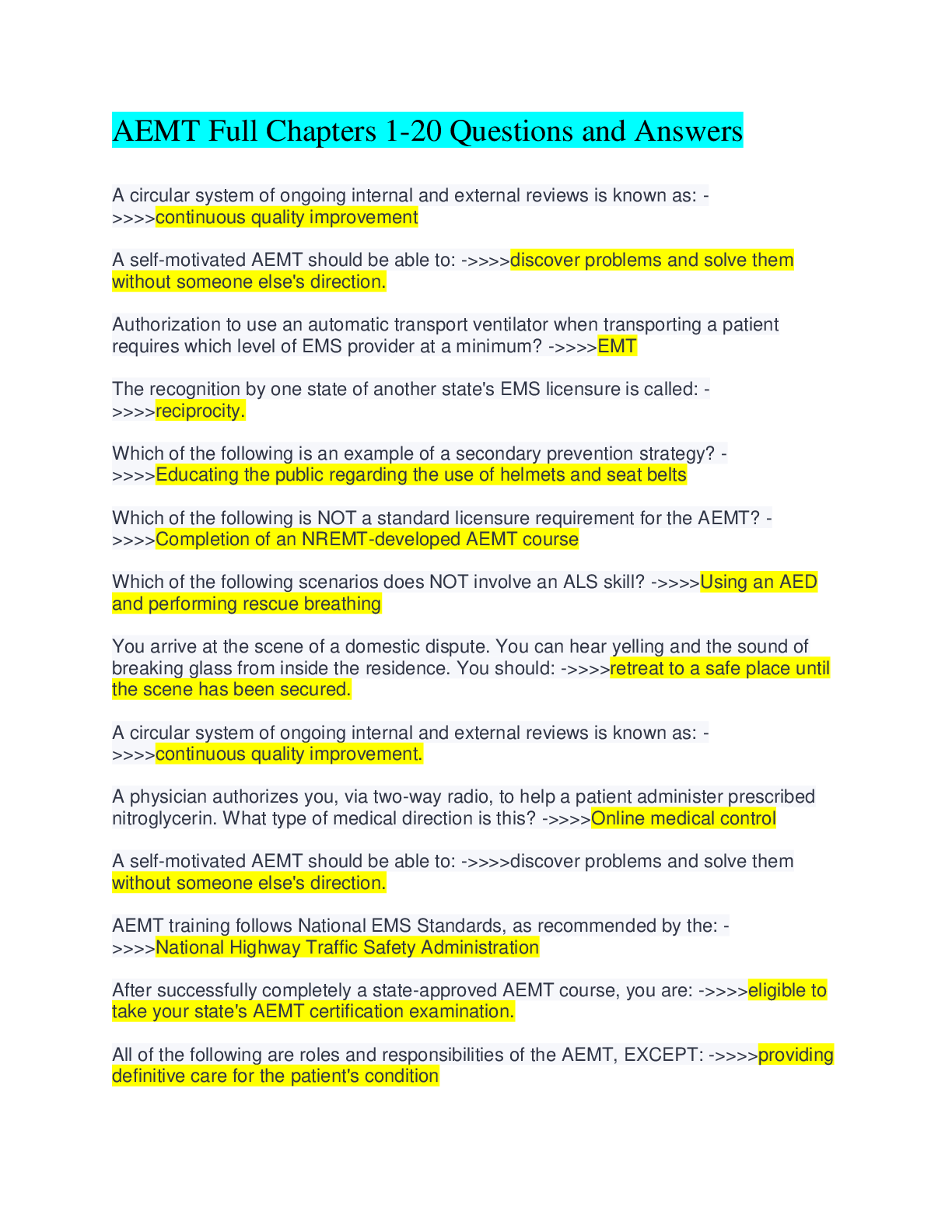
Buy this document to get the full access instantly
Instant Download Access after purchase
Add to cartInstant download
We Accept:

Reviews( 0 )
$12.00
Document information
Connected school, study & course
About the document
Uploaded On
Sep 20, 2022
Number of pages
130
Written in
Additional information
This document has been written for:
Uploaded
Sep 20, 2022
Downloads
0
Views
127












